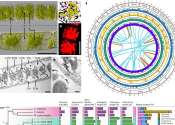Crayfish species proves to be the ultimate survivor
One of the most invasive species on the planet is able to source food from the land as well as its usual food sources in the water, research from Queen Mary, University of London has found.

One of the most invasive species on the planet is able to source food from the land as well as its usual food sources in the water, research from Queen Mary, University of London has found.
Plants & Animals
Aug 3, 2012
2
0

Plant life first emerged on land about 550 million years ago, and an international research team co-led by University of Nebraska–Lincoln computational biologist Yanbin Yin has cracked the genomic code of its humble beginnings, ...
Evolution
May 2, 2024
0
694

As the planet warms, plants are working to slow the effect of human-caused climate change—and research published today in Trends in Plant Science has assessed how plants are responding to increasing carbon dioxide (CO2).
Environment
May 16, 2019
2
578

An elementary school science activity asks children who have each been assigned a wetland plant or animal to connect themselves with string and tape to other "organisms" their assigned plant or animal interacts with in some ...
Ecology
Jun 22, 2012
1
0

Seaweeds are not only tasty, but they are a source of nutrients that could be beneficial for health and wellbeing. And like terrestrial plants, seaweeds also contain significant portions of fibre that reach the colon undigested. ...
Other
Apr 4, 2013
0
0

When we think about pollination, the image that comes first to mind is a bee or a butterfly covered by pollen. However, in the Cretaceous —about 105 million years ago— bees and butterflies did not exist, and most terrestrial ...
Archaeology
Jul 10, 2015
2
82

A new study of sediments laid down shortly after an asteroid plowed into the Gulf of Mexico 65.5 million years ago, an event that is linked to widespread global extinctions including the demise of big dinosaurs, suggests ...
Archaeology
Oct 11, 2011
0
0

(Phys.org) —The Amazon rain forest, popularly known as the lungs of the planet, inhales carbon dioxide as it exudes oxygen. Plants use carbon dioxide from the air to grow parts that eventually fall to the ground to decompose ...
Earth Sciences
May 20, 2013
2
0

More than 50 years ago on the shoreline of a rocky tide pool, the US ecologist Robert Paine discovered that the removal of a single species from an ecosystem could dramatically alter its structure and function. He had discovered ...
Ecology
Mar 31, 2022
0
301

A study by scientists with the U.S. Forest Service, Harvard University and partners suggests that trees are responding to higher atmospheric carbon dioxide levels by becoming more efficient at using water.
Environment
Jul 10, 2013
0
0